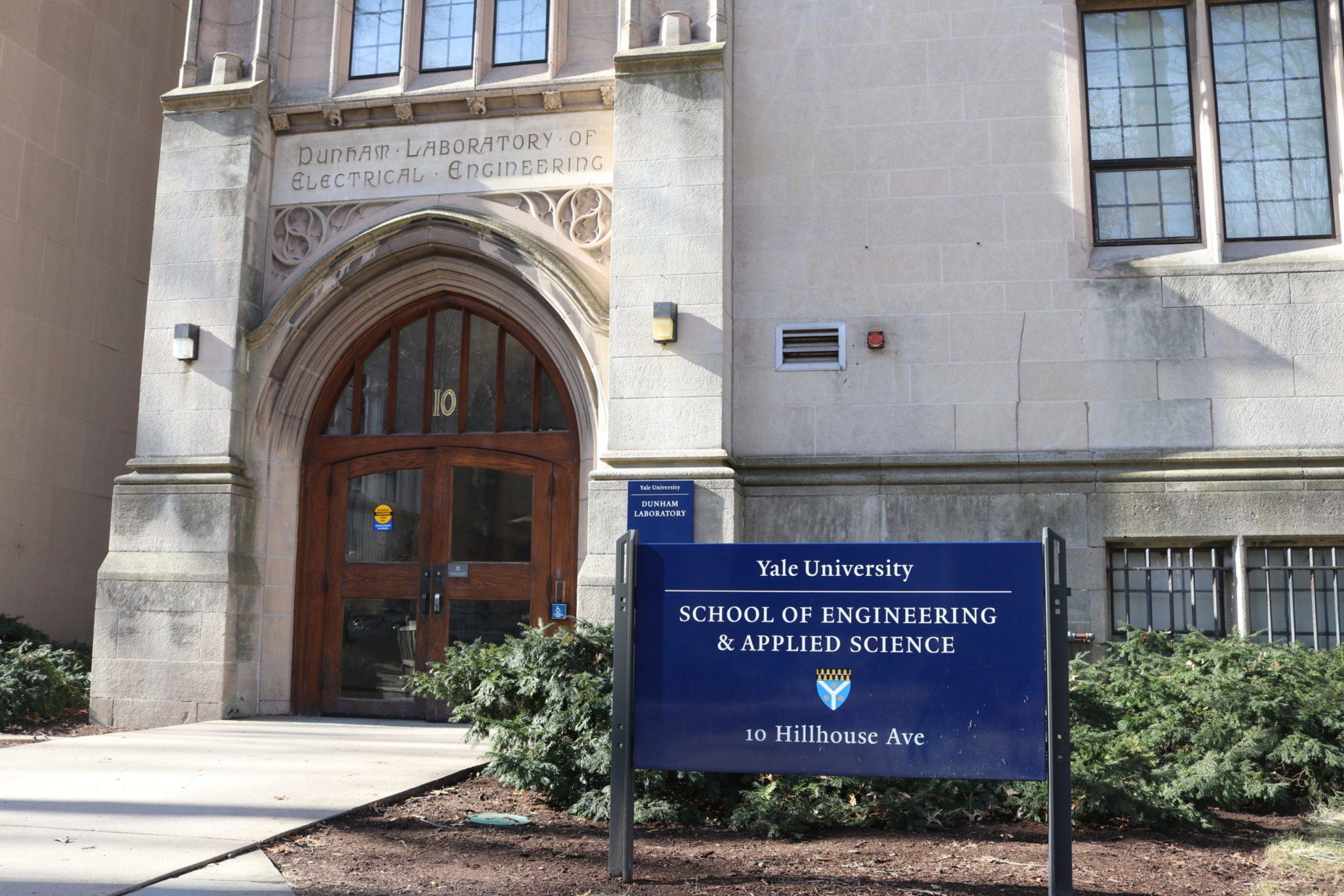
Yale Daily News
Yale’s School of Engineering and Applied Science is completing a strategic plan for the coming years, creating a roadmap for the school that is smaller in size and functions differently from several peer institutions.
University Provost Scott Strobel gave the strategic planning committee its charge in October, tasking it with developing a plan for the next 10 years. A draft could be on the dean’s desk within the next few weeks, according to committee member and electrical engineering professor Rajit Manohar. Because the school is smaller than engineering schools at Yale’s peer institutions, the committee has thought strategically about ways they can improve in select areas, including emphasizing industrial collaboration and entrepreneurship.
The school comprises the applied physics, biomedical engineering, chemical and environmental engineering, computer science, electrical engineering and mechanical engineering and materials science departments. Several of its constituents are ranked lower than other professional schools at Yale. For example, according to U.S. News rankings, Yale is ranked 32nd in the country and 254th in the world for engineering and 124th in the world for computer science. Additionally, the school has a number of administrative oddities — including its placement in the Faculty of Arts and Sciences and unique system of graduate funding — that three faculty interviewed by the News say could stunt the school’s growth and is forcing the committee to clearly and narrowly define the focus points of the strategic plan.
“Since I’ve been here, engineering has been struggling at Yale,” professor of electrical engineering A. Stephen Morse said. “I’m not sure the administrators really know quite what to do with engineering.”
FAS Dean Tamar Gendler said that this year, Yale intends to hire multiple faculty in the computer science department and at least one professor in each of the other SEAS disciplines. Next year, this number will likely increase, she added. The University is also investing in physical infrastructure for engineering, including the Greenberg Teaching Concourse, which includes teaching labs for engineering, Gendler wrote in an email to the News.
The committee is developing goals for the next five to 10 years, as well as strategies and structural changes that will go toward supporting the school while helping the committee stay on track. The University Science Strategy Committee report, which was released in 2018 and included five priority areas in the sciences, indicated that engineering was important, but that the USSC would not comment on explicit priorities for SEAS, according to mechanical engineering and materials science professor Corey O’Hern.
At least one representative from each SEAS department sits on the committee, chaired by Dean of SEAS Jeffrey Brock. Committee members have been meeting regularly with the chair of each SEAS department, representatives from the Provost’s Office, the Office of Cooperative Research, leaders from other schools and leaders of the University-wide science initiatives, since October.
In an email to the News, Brock wrote that he is “deeply optimistic” that the strategic planning process will produce a bold and inclusive vision for SEAS.
“This vision will set out an agenda of innovation and discovery that advances Yale’s strategic priorities, underscores our commitment to research and teaching, and fosters engagement with the world outside of the University,” Brock told the News. “It is a great time to be doing this work to advance SEAS.”
Committee and strategic plan priorities
O’Hern said that the dean and many of the planning committee members want to see more entrepreneurship and industrial collaboration within SEAS. With the infrastructure of Tsai CITY and the CEID, he hopes to see industrial partnerships and faculty incentivized to start companies.
Manohar said that the committee wants to ensure Yale is not falling behind its peers in terms of industrial collaboration and entrepreneurship.
Through discussions with department chairs, the committee determined that they wanted to find areas where Yale “could make a mark,” Manohar said. In every department, there are pockets of incredibly strong faculty, but their expertise is not always visible within the wider community.
It is difficult to “bootstrap” in areas where Yale is not as strong, he said, but the committee has based its conversations on what areas the department chairs recommended could complement the USSC report. For example, Manohar said Yale is strong at quantum materials and quantum systems. The USSC identified quantum science as a top priority.
For his part, Morse cautioned against prioritizing the areas currently popular in engineering. He said quantum science is one of these areas, as is data science. With tenured faculty sometimes staying on for upwards of 50 years, Yale must be concerned with longevity in the areas it prioritizes, Morse said.
The popularity of different fields can ebb and flow, and faculty must be able to shift towards other areas if their specialty goes out of favor. Morse said that in his opinion, the University should focus on appointing professors in the long-standing, traditional areas of engineering: people who may be interested in the popular areas who can also shift specialties if necessary. Morse also suggested that Yale build up in systems biology and autonomous systems.
Once the committee finishes drafting its report, administrators will decide how to allocate funding and appoint individuals across schools.
The size of SEAS
Compared to Yale’s peer institutions, SEAS is a relatively small engineering school. The school has 98 ladder faculty, far lower than MIT Engineering’s 310 and Cornell Engineering’s 267 tenure-track faculty.
While Manohar noted that SEAS is smaller than other engineering schools, he said it was too simple to chalk up obstacles to hiring to a lack of resources.
“Everybody likes to hire more faculty,” Manohar said. “But the engineering school at Yale is significantly smaller than most other places. I mean, significantly is not like 10 percent or 20 percent.”
Manohar’s department, electrical engineering, has about 15 faculty. He said that the corresponding number at other schools falls in excess of 70. This means that SEAS has to focus in on a few choice areas in its strategic plan, as it won’t achieve the breadth that other schools do, Manohar said.
O’Hern seconded that the committee has to be strategic and find a niche for engineering at Yale. According to O’Hern, it is not possible to quickly double or triple the number of faculty, so SEAS has to select targeted areas for growth.
For O’Hern, because SEAS is relatively small, it brings in less research funding compared to its peers and has historically struggled to garner significant grants called “center” grants. Additionally, being small can hinder hiring in research areas where a critical mass has not been established, O’Hern said.
“Every department in SEAS is undersized,” O’Hern said. “It can be by as large as a factor of two or three [times] undersized compared to our peer institutions.”
But there are advantages to SEAS’s small size. Biomedical engineering professor W. Mark Saltzman said that at larger schools, engineering faculty can be “siloed.” By contrast, at Yale, professors can interact with professors in other disciplines much more easily.
Because money is finite, the committee looked at how SEAS’ priorities could dovetail with the areas the USSC identified as well as at some school-specific recommendations. For example, environmental engineering could work with the planetary solutions priority.
SEAS’ role within the FAS
Yale’s School of Engineering and Applied Sciences has a number of structural differences compared to equivalent schools at peer institutions. One of the most glaring differences is that SEAS operates within the Faculty of Arts and Sciences.
Although Manohar said he is not sure of the importance of SEAS’ identity within FAS, he noted that SEAS has less autonomy because the dean of engineering must report to the FAS dean, whereas other schools would have the dean reporting directly to the provost. The engineering dean cannot oversee the budget or hiring in the same way a dean can at other schools, he said.
But that SEAS is a part of the FAS also allows for more interactions between engineering faculty and other FAS departments, according to Manohar.
In the absence of its own endowment, SEAS relies on resources from the FAS and Graduate School of Arts and Sciences. An advantage to being part of the FAS is that it has significant resources for hiring faculty, O’Hern said. But though SEAS has its own dean, FAS leadership also has to approve decisions to increase SEAS faculty numbers.
One potential step forward for the school would be to move SEAS outside of the FAS, according to O’Hern.
“That’s liberating but also difficult, because SEAS would have to become financially independent,” O’Hern said.
Funding for graduate students
Another structural oddity at SEAS that could become part of the strategic plan is the funding model for graduate students, which limits the amount of funding SEAS students can receive. Incoming doctoral students get fellowships from Yale, but faculty cannot use their research grants to recruit any additional doctoral students since Yale dictates the number of doctoral students who are offered admission.
There are two costs associated with hiring graduate students: tuition that goes to the University and a stipend that goes to the student themselves. Different departments have different funding models for graduate students, and the University does not take into account the external resources that a department may be able to offer the students, Manohar said.
It takes five or six years for STEM graduate students to get a doctorate in physics, students get two years of funding covered by the University, and the remainder must be covered by their doctoral adviser. Biology doctoral students get two or three years of support from Yale. By contrast, students in SEAS departments get only one year of University funding, according to O’Hern.
Engineering faculty have to write grants to come up with the remainder of the funds for the students, which is typically upwards of four years of funding, O’Hern said.
In an email to the News, Gendler wrote that Yale changed the funding model that supports graduate study last October. The new model allows faculty to devote a larger proportion of their grant support to research rather than to student funding.
Per the new model, Yale is returning some of the tuition to principal investigators of the labs so they can use it on graduate student support. The principal investigator will still have to get federal grants to support the student’s stipend, but a portion of the tuition payments would be returned and can be used on student funding. O’Hern said this was a relatively small — but good — first step to improve the doctoral student funding model, but that more can be done.
“We don’t control the funding model for our Ph.D. students because we don’t have our own financial resources,” O’Hern said.
The SEAS was founded in 1852.
Rose Horowitch | rose.horowitch@yale.edu









